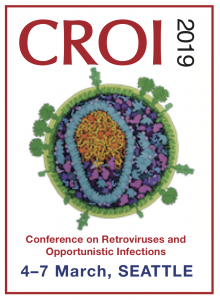Double-dose levonorgestrel implant does not overcome interaction with efavirenz
28 March 2019. Related: Conference reports, Women's health, PK and drug interactions, CROI 26 (Retrovirus) 2019.
Using two levonorgestrel (LNG) implants does not fully overcome the drug-drug interaction with efavirenz (EFV) – according to findings from a pharmacokinetic (PK) evaluation of double-dose LNG in Ugandan women receiving EFV-based ART. [1]
Kim Scarsi presented these data at CROI 2019 on behalf of investigators from University of Nebraska Medical Center; Infectious Disease Institute, Kampala; Northwestern University, Chicago; and University of Liverpool.
LNG is primarily metabolised in the liver by cytochrome P450 (CYP) 3A4. EFV decreases progestin exposure through induction of cytochrome P450.
LNG subdermal implants can be left in place for up to 5 years and are a highly effective form of contraception with less than 1% risk of unintended pregnancy.
Professor Scarsi’s group previously found 45–57% lower LNG exposure in women using the implant at standard dose (150mg) with EFV-based ART compared to ART-naive women. [2, 3]
In that earlier study, 3 of 20 women (15%) had an unintended pregnancy within 48 weeks of combined LNG-EFV use. LNG concentrations were ≤303 pg/mL in the 3 women at the visit before pregnancy; 18 (90%) women had any LNG concentration ≤303 pg/mL during the study.
The aim of the study presented was to see if the LNG-EFV interaction could be overcome with double-dose LNG (300 mg) implants over 48 weeks in women receiving EFV-based ART, compared with historical controls.
It was an open label, sparse-sampling PK study. Women receiving EFV 600 mg based ART, with undetectable viral load, had LNG implants placed sub-dermally in each upper arm (DoubLNG group; n=28). All participants were also given a copper IUD as an additional form of contraception.
Historical controls were ART-naive Ugandan women (n=17) who received a standard-dose LNG implant.
Sampling was performed pre-implant and at weeks 1, 4, 12, 24, 36, and 48. There were optional study visits for 4 weeks after week 48 to assess endogenous progesterone as an indicator of ovarian activity (threshold 3 or 4 ng/mL).
All women were black African. The DoubLNG group was a median age of 33 years and median weight of 58 kg; the control group was 29 years and 69 kg.
At week 48, LNG concentrations were 373 pg/mL (319 to 540) in the DoubLNG group vs 651 pg/mL (469 to 879) in the control group: GMR 0.66 (90% CI 0.61 to 0.72), p=0.003. This reduction in exposure was similar weeks 1 through 48.
Despite the double-dose of LNG implants, concentrations remained 33–44% lower in women receiving EFV-based ART plus LNG vs ART-naive women on standard dose LNG.
More women in the DoubLNG group vs the control group had any LNG value ≤303 pg/mL: 13 (46%) vs 3 (18%), respectively, p=0.06. About 90% were below this threshold in the earlier study.
Approximately 20–25% of participants in the DoubLNG group (n=24) had endogenous serum progesterone levels reflecting ovulation vs 10–15% expected to have ovulation in the first year of LNG use, based on historical data.
comment
The reduction in concentrations was smaller with the double-dose compared with the standard dose used in the earlier study: 34 vs 57%. But although it increased exposure a bit, doubling the dose of LNG implants did not fully overcome the interaction with EFV.
Professor Scarsi described this as a “surprising finding” and explained that the contraceptive effectiveness of this approach remains uncertain. She remarked that these results may have complicated the challenges around providing contraception for women on EFV-based ART.
References
- Scarsi K et al. Double-dose levonorgestrel implant does not fully overcome interaction with efavirenz. CROI 2019. Seattle. 4–7 March 2019. Oral abstract 51.
http://www.croiconference.org/sessions/double-dose-levonorgestrel-implant-does-not-fully-overcome-interaction-efavirenz (abstract)
http://www.croiwebcasts.org/p/2019croi/51 (webcast) - Clayden P. Unintended pregnancies with levonorgestrel implant due to drug interactions with efavirenz-based ART. HTB. 24 March 2015.
https://i-base.info/htb/28063 - Scarsi K et al. Unintended pregnancies observed with combined use of the levonorgestrel contraceptive implant and efavirenz-based antiretroviral therapy: a three-arm pharmacokinetic evaluation over 48 weeks. Clin Infect Dis. Volume 62, Issue 6. 15 March 2016.
https://academic.oup.com/cid/article/62/6/675/2462703

 Polly Clayden, HIV i-Base
Polly Clayden, HIV i-Base